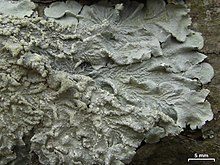Canoparmelia is a genus of lichen-forming fungi in the family Parmeliaceae. The widespread genus contains about 35 species.[2] Canoparmelia, a segregate of the parmelioid lichen genus Pseudoparmelia, was circumscribed by John Elix and Mason Hale in 1986.[1]
| Canoparmelia | |
|---|---|

| |
| Canoparmelia texana | |
| Scientific classification | |
| Domain: | Eukaryota |
| Kingdom: | Fungi |
| Division: | Ascomycota |
| Class: | Lecanoromycetes |
| Order: | Lecanorales |
| Family: | Parmeliaceae |
| Genus: | Canoparmelia Elix & Hale (1986)[1] |
| Type species | |
| Canoparmelia texana | |
Description
editCanoparmelia lichens have grey or rarely yellow-green thalli containing the secondary chemicals atranorin and chloroatranorin, or rarely usnic acid, in the cortex. The thallus is made of more or less rotund lobes that are 3.0–5.0 mm wide and lack cilia; the medulla is white. The underside of the thallus is black or brown with naked brown margins and simple rhizines of the same colour. Canoparmelia produces small ellipsoid ascospores that measure 10–14 by 6–8 μm. The conidia are fusiform (spindle-shaped) or bifusiform, measuring 7–10 μm long.[1][3]
Species
edit- Canoparmelia alabamensis (Hale & McCull.) Elix (2001)
- Canoparmelia albomaculata C.H.Ribeiro & Marcelli (2002)[4] – Brazil
- Canoparmelia amabilis Heiman & Elix (1999)[5]
- Canoparmelia antedeluvialis (Brusse & Sipman) Elix (1997)
- Canoparmelia aptata (Kremp.) Elix & Hale (1986)
- Canoparmelia austroamericana Adler (1987)[6]
- Canoparmelia caribaea (Hale) Elix & Hale (1986)
- Canoparmelia caroliniana (Nyl.) Elix & Hale (1986)
- Canoparmelia cassa Marcelli & C.H.Ribeiro (2002)[4] – Brazil
- Canoparmelia concrescens (Vain.) Elix & Hale (1986)
- Canoparmelia consanguinea Marcelli, Canêz & Elix (2009)[7] – Brazil
- Canoparmelia corrugativa (Kurok. & Filson) Elix & Hale (1986)
- Canoparmelia cryptochlorophaea (Hale) Elix & Hale (1986)
- Canoparmelia ecaperata (Müll.Arg.) Elix & Hale (1986)
- Canoparmelia epileuca (Hale) Elix & Hale (1986)
- Canoparmelia eruptens (Kurok.) Elix & Hale (1986)
- Canoparmelia herveyensis Elix (1993)[8] – Australia
- Canoparmelia inornata (Hale) Elix & Hale (1986)
- Canoparmelia martinicana (Nyl.) Elix & Hale (1986)
- Canoparmelia nairobiensis (J.Steiner & Zahlbr.) Elix & Hale (1986)
- Canoparmelia nashii Jungbluth & Marcelli (2011)[9]
- Canoparmelia owariensis (Asahina) Elix (1993)
- Canoparmelia pustulescens (Kurok.) Elix (1993)
- Canoparmelia pustulifera Benatti, S.M.Martins, C.Vos & Emily Holt (2017)[10] – Brazil
- Canoparmelia quintarigera Aptroot (1991)[11] – Magagascar
- Canoparmelia rarotongensis Louwhoff & Elix (2000)[12] – Rarotonga
- Canoparmelia raunkiaeri (Vain.) Elix & Hale (1986)
- Canoparmelia rodriguesiana (Hue) Elix (1999)
- Canoparmelia roseoreagens Marcelli, Canêz & Elix (2009)[7] – Brazil
- Canoparmelia rupicola (Lynge) Elix (2001)
- Canoparmelia sanguinea Marcelli, Benatti & Elix (2009)[13] – Brazil
- Canoparmelia somaliensis (Müll.Arg.) Elix & Hale (1986)
- Canoparmelia subroseoreagens Marcelli, Canêz & Elix (2009)[7] – Brazil
- Canoparmelia tamaulipensis T.H.Nash & R.-E.Pérez (2010)
- Canoparmelia terrapapia Elix (1999)[14]
- Canoparmelia texana (Tuck.) Elix & Hale (1986)
- Canoparmelia zambiensis (Hale) Elix & Hale (1986)
- Canoparmelia zimbabwensis (Hale) Elix & Hale (1986)
The taxon once named Canoparmelia amazonica (Nyl.) Elix & Hale (1986) has been analysed molecularly and shown to belong in the genus Parmelinella.[15]
References
edit- ^ a b c Elix, J.A.; Johnston, J.; Vernon, D. (1986). "Canoparmelia, Paraparmelia and Relicinopsis. Three new genera in the Parmeliaceae (lichenized Ascomycotina)". Mycotaxon. 27: 271–282.
- ^ Wijayawardene, Nalin; Hyde, Kevin; Al-Ani, Laith Khalil Tawfeeq; Somayeh, Dolatabadi; Stadler, Marc; Haelewaters, Danny; et al. (2020). "Outline of Fungi and fungus-like taxa". Mycosphere. 11: 1060–1456. doi:10.5943/mycosphere/11/1/8. hdl:10481/61998.
- ^ Elix, John A. (1993). "Progress in the generic delimitation of Parmelia sensu lato lichens (Ascomycotina: Parmeliaceae) and a synoptic key to the Parmeliaceae". Bryologist. 96 (3): 359–383. doi:10.2307/3243867. JSTOR 3243867.
- ^ a b Marcelli, M.; Ribeiro, C.H. (2002). "Twenty-one new species of Parmeliaceae (lichenized fungi) from southeastern Brazil". Mitteilungen aus dem Institut für Allgemeine Botanik Hamburg. 30–32: 125–155.
- ^ Heiman, K.; Elix, J.A. (1999). "A new species of Canoparmelia from North America (lichenized Ascomycotina, Parmeliaceae)". Mycotaxon. 70: 163–166.
- ^ Adler, M.T. (1987). "A new species of the genus Canoparmelia from Argentina". Mycotaxon. 28 (1): 251–254.
- ^ a b c Canêz, L.; Marcelli, M.P.; Elix, J.A. (2009). "New Brazilian species of Canoparmelia with medullary olivetoric, anziaic, and sekikaic complexes". Mycotaxon. 110: 465–472. doi:10.5248/110.465.
- ^ Elix, John A. (1993). "New species in the lichen family Parmeliaceae (Ascomycotina) from Australia". Mycotaxon. 47: 101–129.
- ^ Marcelli, M.P.; Canez, L.S.; Benatti, M.N.; Spielmann, A.A.; Jungbluth, P.; Elix, J.A. (2011). "Taxonomical novelties in Parmeliaceae". Bibliotheca Lichenologica. 106: 211–224.
- ^ Benatti, Michel Navarro; Martins, Suzana de Azevedo; Vos, Carlo; Holt, Emily (2017). "Canoparmelia pustulifera, a new species of Parmeliaceae containing perlatolic acid from southern Brazil". Iheringia. 72 (2): 283–286. doi:10.21826/2446-8231201772215.
- ^ Aptroot, A. (1991). "Lichens of Madagascar: new records and species of Parmeliaceae". Cryptogamie Bryologie Lichénologie. 12 (2): 149–154.
- ^ Simone Louwhoff, H.J.J.; Elix, John A. (2000). "The Lichens Of Rarotonga, Cook Islands, South Pacific Ocean II: Parmeliaceae". The Lichenologist. 32 (1): 49–55. doi:10.1006/lich.1999.0237. S2CID 84916551.
- ^ Benatti, M.N.; Marcelli, M.P.; Elix, J.A. (2008). "Canoparmelia sanguinea, a new Parmeliaceae from Brazil". Mycotaxon. 106: 435–439.
- ^ Elix, J.A. (1999). "Further new species and new reports in the lichen family Parmeliaceae (Ascomycotina) from South Africa". Mycotaxon. 70: 103–110.
- ^ Rodrigues, Andressa S.; Canêz, Luciana S.; Lorenz, Aline P. (2021). "Canoparmelia amazonica, Myelochroa lindmanii and Parmelinella salacinifera belong to Parmelinella (Parmeliaceae)". The Bryologist. 124 (3): 352–361. doi:10.1639/0007-2745-124.3.352. S2CID 237773315.